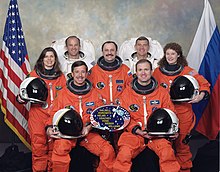STS-101
This article's lead section may be too short to adequately summarize the key points. (February 2009) |
This article includes a list of references, related reading, or external links, but its sources remain unclear because it lacks inline citations. (May 2008) |
| COSPAR ID | 2000-027A |
|---|---|
| SATCAT no. | 26368 |
| End of mission | |

 | |
STS-101 was a Space Shuttle mission to the International Space Station (ISS) flown by Space Shuttle Atlantis. The mission was a 10-day mission conducted between May 19, 2000 and May 26, 2000. The mission was designated 2A.2a and was a resupply mission to the International Space Station. STS-101 was delayed 3 times in April due to high winds. STS-101 traveled 4.1 million miles and completed 155 revolutions of the earth and landed on runway 15 at Kennedy Space Center. The mission was the first to fly with the "glass cockpit".
Crew
- James D. Halsell, Jr. (5), Commander
- Scott J. Horowitz (3), Pilot
- Mary E. Weber (2), Mission Specialist 1
- Jeffrey N. Williams (1), Mission Specialist 2
- James S. Voss (4), Mission Specialist 3
- Susan J. Helms (4), Mission Specialist 4
- Yury V. Usachev (3), Mission Specialist 5 -
 Russia
Russia
Number in parentheses indicates number of spaceflights by each individual prior to and including this mission.
Mission parameters
- Mass:
- Orbiter landing with payload: 100,369 kg
- Payload: 1,801 kg
- Perigee: 332 km
- Apogee: 341 km
- Inclination: 51.6°
- Period: 91 min
Docking with ISS
- Docked: May 20, 2000, 04:30:45 UTC
- Undocked: May 26, 2000, 23:03:00 UTC
- Time Docked: 5 days, 18 h, 32 min, 15 s
Space walks
- Voss and Williams - EVA 1
- EVA 1 Start: May 22, 2000 - 01:48 UTC
- EVA 1 End: May 22, - 08:32 UTC
- Duration: 6 hours, 44 minutes
Mission highlights

The primary mission objectives for STS-101 was to deliver supplies to the International Space Station, perform a spacewalk and then reboost the station from 230 to 250 statute miles (370 to 402 km).
Detailed objectives included ISS ingress/safety to take air samples, monitor carbon dioxide, deploy portable, personal fans, measure air flow, rework/modify ISS ducting, replace air filters, and replace Zarya fire extinguishers and smoke detectors. Critical replacements, repairs and spares were also done to replace four suspect batteries on Zarya, replace failed or suspect electronics for Zarya's batteries, replace Radio Telemetry System memory unit, replace port early communications antenna, replace Radio Frequency Power Distribution Box and clear Space Vision System target.

The mission also included incremental assembly/upgrades such as assembly of Strela crane, installation of additional exterior handrails, set up of center-line camera cable, installation of "Komparus" cable inserts and reseating the U.S. crane. Assembly parts, tools and equipment were also transferred to the station and equipment stowed for future missions.
The station was also resupplied with water, a docking mechanism accessory kit, film and video tape for documentation, office supplies and personal items. Crew health maintenance items were also transferred including exercise equipment, medical support supplies, formaldehyde monitor kit and a passive dosimetry system.
This mission was almost similar to the Columbia disaster. A damaged tile seam caused a breach which allowed superheated gas to enter the left wing during reentry. The gas did not penetrate deeply and the damage was repaired before the next flight. If it had penetrated deeply the Shuttle could have been destroyed during reentry.
This mission was the first mission to fly with a glass cockpit.
See also
- Space science
- Space shuttle
- List of space shuttle missions
- List of human spaceflights chronologically
- List of ISS spacewalks
- List of spacewalks



